Steroid-resistant neutrophilic inflammation in a mouse model of an acute exacerbation of asthma
- PMID: 18474669
- PMCID: PMC2643207
- DOI: 10.1165/rcmb.2008-0028OC
Steroid-resistant neutrophilic inflammation in a mouse model of an acute exacerbation of asthma
Abstract
Neutrophilic inflammation in acute exacerbations of asthma tends to be resistant to treatment with glucocorticoids. This may be related to decreased activity and expression of histone deacetylase-2 (HDAC2), which down-regulates expression of proinflammatory genes via recruitment to the glucocorticoid receptor complex. We assessed airway inflammation and response to steroid treatment in a novel mouse model of an acute exacerbation of chronic asthma. Systemically sensitized mice received low-level challenge with aerosolized ovalbumin for 4 weeks, followed by a single moderate-level challenge to induce enhanced inflammation in distal airways. We assessed the effects of pre-treatment with dexamethasone on the accumulation of inflammatory cells in the airways, airway responsiveness to methacholine, expression and enzymatic activity of nuclear proteins including histone acetyl transferase (HAT) and HDAC2, and levels of transcripts for neutrophil chemoattractant and survival cytokines. Dexamethasone suppressed inflammation associated with eosinophil and T-lymphocyte recruitment, but did not prevent neutrophil accumulation or development of airway hyperresponsiveness. Increased activity of HAT was suppressed by steroid treatment, but the marked diminution of HDAC2 activity and increased activity of nuclear factor-kappaB were not reversed. Correspondingly, elevated expression of mRNA for TNF-alpha, granulocyte-macrophage colony-stimulating factor, IL-8, and p21(waf) were also not suppressed by dexamethasone. Levels of lipid peroxidation and protein nitration products were elevated in the acute exacerbation model. We conclude that impaired nuclear recruitment of HDAC2 could be an important mechanism of steroid resistance of the neutrophilic inflammation in exacerbations of asthma. Oxidative stress may contribute to decreased HDAC2 activity.
Figures
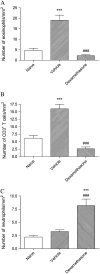

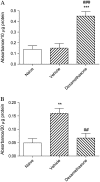
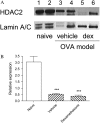

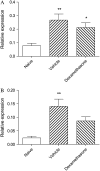

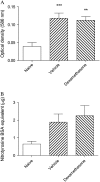
References
-
- Bousquet J, Jeffery PK, Busse WW, Johnson M, Vignola A. Asthma: from bronchoconstriction to airways inflammation and remodeling. Am J Respir Crit Care Med 2000;161:1720–1745. - PubMed
-
- Gibson PG, Simpson JL, Saltos N. Heterogeneity of airway inflammation in persistent asthma: evidence of neutrophilic inflammation and increased sputum interleukin-8. Chest 2001;119:1329–1336. - PubMed
-
- Lamblin C, Gosset P, Tillie-Leblond I, Saulnier F, Marquette CH, Wallaert B, Tonnel AB. Bronchial neutrophilia in patients with noninfectious status asthmaticus. Am J Respir Crit Care Med 1998;157:394–402. - PubMed
-
- Fahy JV, Kim KW, Liu J, Boushey HA. Prominent neutrophilic inflammation in sputum from subjects with asthma exacerbation. J Allergy Clin Immunol 1995;95:843–852. - PubMed

